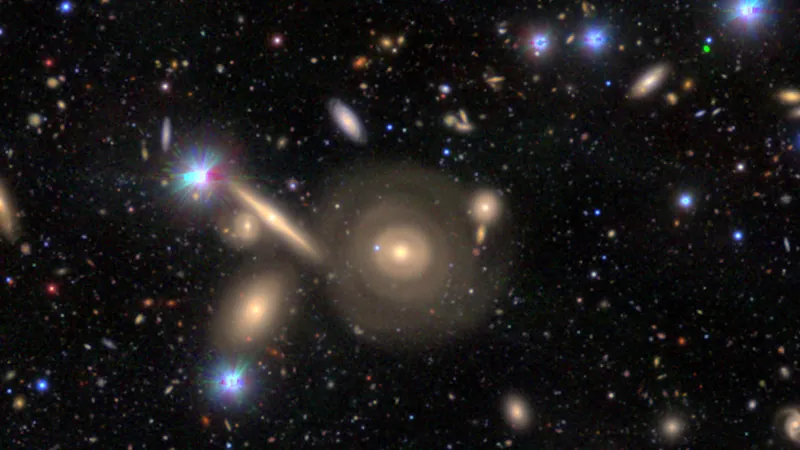
Astounding Discovery: Rare Triple-Ring Galaxy Found, Leaving Astronomers Baffled!
2024-11-13
Author: Wei
Astounding Discovery: Rare Triple-Ring Galaxy Found, Leaving Astronomers Baffled!
In an incredible revelation, researchers have captured a breathtaking image of a rare triple-ring galaxy, located a staggering 800 million light-years away from Earth. This phenomenal discovery, made by the Subaru Telescope on Mauna Kea in Hawaii, has caused waves in the scientific community as it challenges the traditional classification of galaxies. Officials from Japan's National Astronomical Observatory announced this find with excitement, highlighting its uniqueness and the mystery surrounding its formation.
Galaxy Classification: A Traditional View
Typically, galaxies are classified under a system known as the Hubble sequence, which divides them into four main categories: elliptical, lenticular, spiral, and irregular. Elliptical galaxies often appear smooth and oval-shaped, while lenticular galaxies resemble flattened ellipses with a central bulge. Spiral galaxies, such as our Milky Way, showcase a swirling structure with distinct arms, while irregular galaxies lack any organized form.
A Challenge to Traditional Classification
However, the newly discovered triple-ring galaxy has left astronomers scratching their heads, as it doesn't neatly fit into these established frameworks. This anomaly has led some scientists and amateur astronomers to argue that the Hubble classification system is in dire need of a revision, as it fails to account for the complexities of ring galaxies.
How Do Ring Galaxies Form?
Galaxies typically follow two predictable evolutionary paths, but the formation of ring galaxies remains a conundrum. One prevalent hypothesis is that these intriguing formations are the result of celestial collisions. When another galaxy collides with a spiral galaxy, it creates shockwaves that send ripples of gas and dust spiraling outward, ultimately forming the rings.
Another potential explanation for the occurrence of ring galaxies stems from the concept of natural resonance. As gases within a galaxy move and interact, gravitational forces can cause them to congregate in specific areas, leading to the creation of ring shapes around the galaxy. Sometimes, this phenomenon can even produce multiple rings.
Looking Ahead: The Future of Galaxies
As researchers continue to unravel the mysteries of the universe, this unusual find raises pertinent questions about the nature of galaxies and their classifications. What other hidden wonders lie beyond our observational reach? Only time and further research will tell! Stay tuned as astronomers delve deeper into the cosmos and reveal secrets that could redefine our understanding of galactic evolution.


 Brasil (PT)
Brasil (PT)
 Canada (EN)
Canada (EN)
 Chile (ES)
Chile (ES)
 España (ES)
España (ES)
 France (FR)
France (FR)
 Hong Kong (EN)
Hong Kong (EN)
 Italia (IT)
Italia (IT)
 日本 (JA)
日本 (JA)
 Magyarország (HU)
Magyarország (HU)
 Norge (NO)
Norge (NO)
 Polska (PL)
Polska (PL)
 Schweiz (DE)
Schweiz (DE)
 Singapore (EN)
Singapore (EN)
 Sverige (SV)
Sverige (SV)
 Suomi (FI)
Suomi (FI)
 Türkiye (TR)
Türkiye (TR)